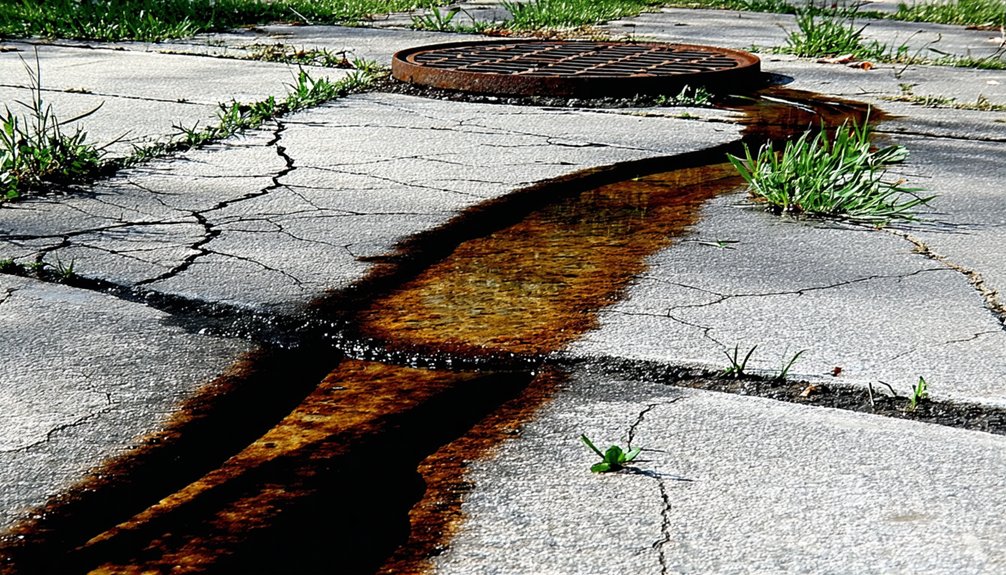Recognizing signs of sewer line failure is essential for homeowners. Common indicators include frequent toilet backups, slow-draining sinks, and foul odors emanating from drains. Additionally, lush patches of grass in the yard or gurgling noises from fixtures may suggest underlying issues. Ignoring these symptoms can lead to significant consequences, including structural damage and health risks. Timely professional inspection and intervention are crucial. Understanding these warning signs can help maintain a healthy plumbing system and protect property value.
Common Indicators of Sewer Line Failure
When homeowners notice unusual plumbing issues, they may be witnessing the early signs of sewer line failure. Frequent toilet backups, particularly those occurring despite proper usage, often indicate an underlying problem with the sewer line. Additionally, slow draining sinks and tubs serve as critical signs of possible blockages within the main sewer pipe, demanding immediate intervention to avert flooding and more plumbing issues. Foul sewer odors emanating from drains typically suggest sewage backups or contamination, necessitating urgent investigation. Moreover, unusually lush patches of grass in the yard may signal leaks from a broken sewer line, as organic materials promote accelerated growth. Finally, the presence of mold and mildew in unexpected areas, such as ceilings or walls, can indicate hidden leaks within sewer lines, reinforcing the need for professional inspection to address these significant concerns effectively. Recognizing these indicators is essential for maintaining a healthy plumbing system.
Consequences of Ignoring Sewer Line Issues
Neglecting sewer line issues can lead to a cascade of severe consequences that extend beyond mere plumbing inconveniences. Homeowners who overlook signs of a broken plumbing system may find themselves facing significant damage and costly repairs.
- Cracked sewer lines can cause slow drains and backed-up toilets, creating unsanitary conditions.
- Mold and mildew growth may arise from moisture infiltration, posing serious health risks.
- Foundation damage can occur due to water seepage, risking the structural integrity of the home.
Moreover, increased pest infestations, such as rodents and insects, often stem from deteriorating sewer conditions, leading to further discomfort and potential health hazards. Long-term neglect exacerbates environmental concerns, contributing to soil contamination and diminishing property value. Consequently, recognizing and addressing sewer line issues promptly is essential to preserving both health and home.
Steps to Take When You Suspect a Sewer Line Problem
Recognizing the early signs of a sewer line problem is essential for homeowners to mitigate potential damage and costly repairs. When a homeowner observes frequent toilet backups or slow draining fixtures, it may signal a problem within the main sewer line that warrants special attention. Foul odors, indicative of sewer gas, should not be ignored, as they pose health risks and require immediate action. Additionally, unusual lush patches of grass or pooling water in the yard can suggest leaks from a compromised sewer line, acting as an inadvertent fertilizer. Visible mold or mildew growth on walls or ceilings may also be a sign of broken pipes, necessitating professional evaluation. Gurgling sounds from toilets or drains often indicate trapped air or blockages, prompting the need for a thorough inspection. In these scenarios, it is a good idea to consult a plumbing professional to prevent sewage from backing into your home.
Frequently Asked Questions
How Do I Know if My Main Sewer Line Is Broken?
Identifying a broken main sewer line involves observing several critical indicators. Frequent backups and clogged drains suggest underlying issues. Unusual odors emanating from drains signal potential leaks. Slow drainage across multiple fixtures can point to severe blockages. Sewer gurgling sounds indicate trapped air, while water pooling and excessive lawn wetness may reveal leaks. Tree roots and pipe corrosion can further exacerbate these problems, necessitating immediate professional assessment to avert extensive damage.
Is Sewer Line Damage Covered by Homeowners Insurance?
Homeowners insurance may cover sewer damage, but coverage limits and policy exclusions often complicate matters. Homeowners must recognize their responsibilities, including routine plumbing inspections and maintenance tips to prevent issues. Filing claims for damage due to negligence may be denied, while damage from natural causes is typically covered. Understanding the claim process in advance can mitigate unexpected costs and guarantee homeowners navigate their policy effectively to address potential sewer line failures.
How Do You Tell if You Have a Sewage Problem?
Identifying a sewage problem involves several indicators. Clogged drains, foul odors, and slow drainage often suggest underlying plumbing issues. Gurgling sounds from fixtures can indicate air trapped in the lines, while water backups in sinks or toilets warrant immediate attention. The presence of wet spots in the yard or unusual noises from the plumbing may signal sewage leaks. Additionally, tree roots can intrude on sewer lines, exacerbating these issues and requiring professional assessment.
How Do I Test My Main Sewer Line?
To test the main sewer line, one should conduct a sewer line inspection utilizing a plumbing camera to visualize the interior condition of the pipes. Monitoring water flow can reveal blockages or pipe leaks. Accessing a sewer cleanout allows for easier inspection. Odor detection can indicate issues, while DIY testing may include checking for root intrusion. For thorough analysis, a professional assessment is recommended to guarantee the drainage system's integrity and functionality.



